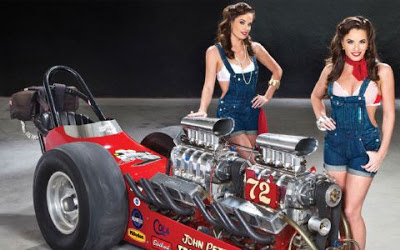The two interests make a lot of sense now as I look back on that era. Both drag racing and rock music were seeing cataclysmic upheavals in all aspects, reflecting the wild times of American culture in general.
Two things in particular characterized drag strip culture in that era: a sense of wild innovation, and an appreciation of the importance of show biz.
 |
| Computer say, driver do: drag racing in the modern era... |
Modern drag racing is similar to the other big budget sports - those big sponsorships demand professionalism and consistency of results. Anything that results in a dragster going faster now is most likely an innovation emerging from computer diagnostics.
 |
| John Peters' historic "Freight Train," restored for the enjoyment of future generations. Groundpounder, indeed... |
In the late 1960s, though, computers took up entire rooms and were the domain of the pocket protector gang. Out at the strip, “going faster” was something obtained - or totally missed - by best guesses. “Hey, that thing goes pretty fast with one engine. What if we put in two?” Or, “Well, it looks aerodynamic to me.”
What hurts drag racing today is that there’s little reward in trying out wild ideas. There are banks of data that answer all the questions before attempts are ever made, with the result that everybody’s running just about the same thing.
It’s rare to see something startling on the track. In the late 1960s, it was almost expected.
Of course, earlier I mentioned the show biz aspect. We’ll take a peak at that down the road, but here’s a hint of what I’m talking about!
 |
| Just another day at the office... |



No comments:
Post a Comment